IT
Buongiorno a tutta la community!
Oggi vi voglio parlare di #Cannabis ed in particolare della sua proibizione durante il 20° secolo, penso sia una storia che non tutti conoscono e sulla quale vale la pena rifletterci sopra.
La Cannabis come ben sappiamo è una #pianta che fa parte del nostro ecosistema da milioni di anni, fa parte della civiltà umana e dei suoi usi e costumi dai tempi più antichi ed ha avuto un ruolo rilevante se non fondamentale nei suoi utilizzi agricoli/industriali fino agli inizi del secolo scorso e poi…il buio più totale.
Dall’inizio del #proibizionismo l’ignoranza che si è fatta strada attorno a questo argomento è veramente impressionante, molti non sanno nemmeno di che cosa si tratta esattamente, c’è tantissima confusione e pochissimo interesse. Eppure fino ad un paio di generazioni prima della nostra questo prodotto di madre terra era all’ordine del giorno!
Ma cosa può spingere l’essere umano a dichiarare guerra ad una pianta così comune? La sua pericolosità, come ci hanno raccontato per decenni? Probabilmente sì, ma la pericolosità di cui si parla, non è legata alla salute come ci hanno voluto far credere, ma si parla di pericolosità nei confronti di poteri che l'hanno ritenuta d’intralcio nei propri interessi, o che ne hanno fatto una bandiera per incriminare qualche scomoda realtà sociale.
Ebbene si, questi sono i veri moventi del proibizionismo e della guerra alla Cannabis: razzismo ed interessi economici.
Di seguito ripercorriamo la cronistoria del proibizionismo e qualche curiosità in merito.
1600s: Nel nuovo mondo la produzione domestica di canapa si rivelò proficua nelle 13 colonie: l'assemblea della Virginia nel 1619 impose agli agricoltori di coltivare la canapa, prodotto talmente importante da essere usato anche come moneta legale sulla costa orientale prima della guerra civile.
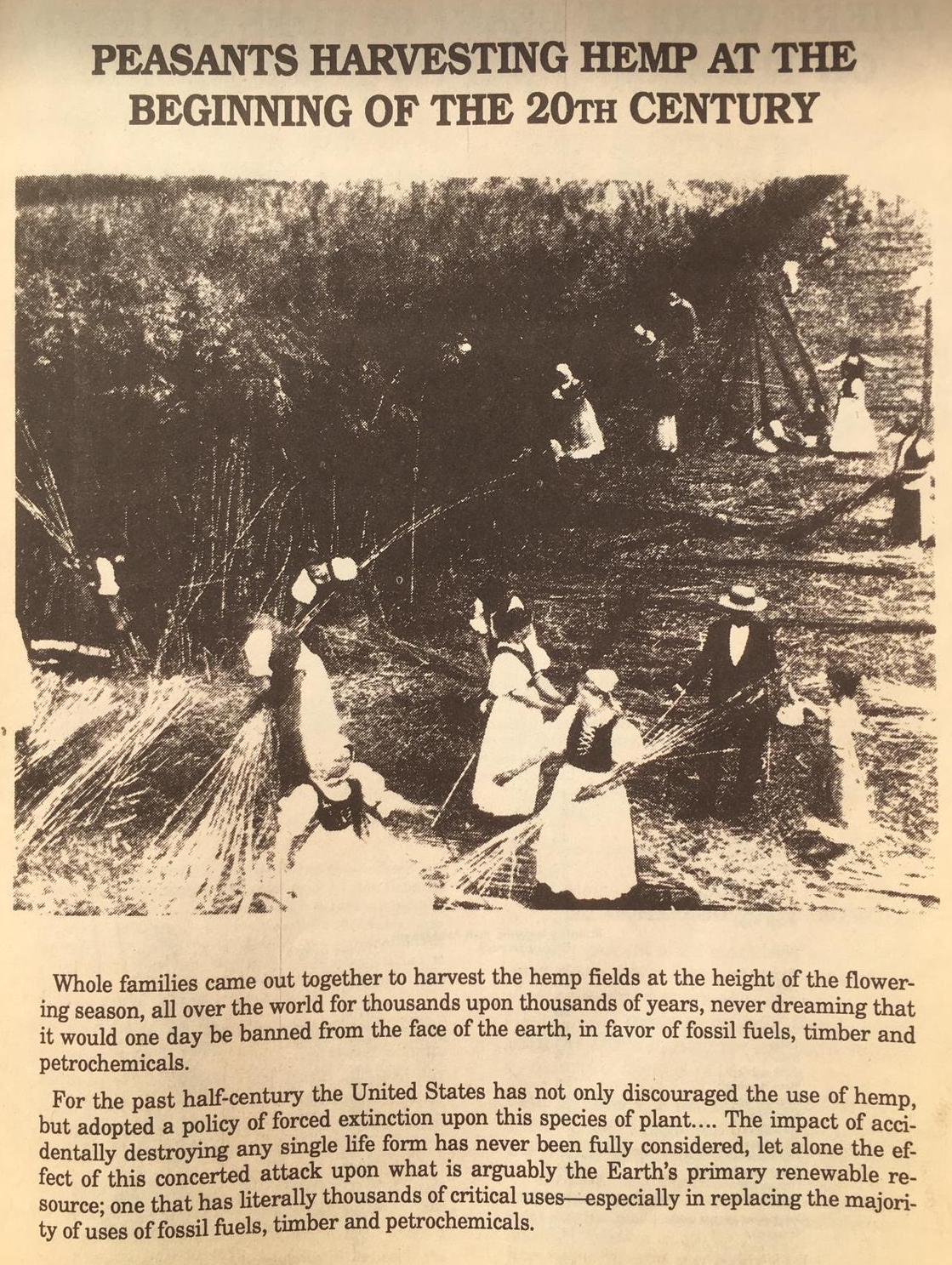
1850: La Cannabis fu aggiunta alla farmacopea degli Stati Uniti per trattare vari sintomi come la dipendenza da oppiacei, l'alcolismo, la lebbra e i dolori mestruali.
1906: Il presidente Teddy Roosevelt firmò il "Pure Food and Drug Act” in cui fu imposta l'etichettatura dei rimedi da banco. Alcol, morfina, oppio, eroina e marijuana furono etichettati come “assuefacenti" e/o "pericolosi".
https://en.wikipedia.org/wiki/Pure_Food_and_Drug_Act
1900-20s: Dopo la rivoluzione messicana i flussi di immigrati messicani in Texas e Louisiana aumentò e con esso la paura ed il pregiudizio contro la cultura messicano-americana.
1930s: Negli anni successivi iniziò una vera e propria campagna di demonizzazione di questa pianta. Il governo degli Stati Uniti vietò la sostanza denominata “Marihuana”, termine che veniva utilizzato dai messicani per identificare la cannabis. Il popolo americano non sapeva ricondurre questo termine alla comune cannabis venduta come rimedio da banco, fu così che il governo potè vietare la Marihuana vietando di fatto anche la cannabis senza dover affrontare alcuna opposizione. La propaganda cominciò ad accusare questa sostanza di essere la causa dei comportamenti aggressivi e violenti delle minoranze sociali (messicani e afroamericani) e di essere un pericolo per le donne bianche e i giovani americani che avrebbero potuto impazzire facendone uso. Tutto questo in un periodo di grande depressione economica e di grandi tensioni all’interno della società americana.
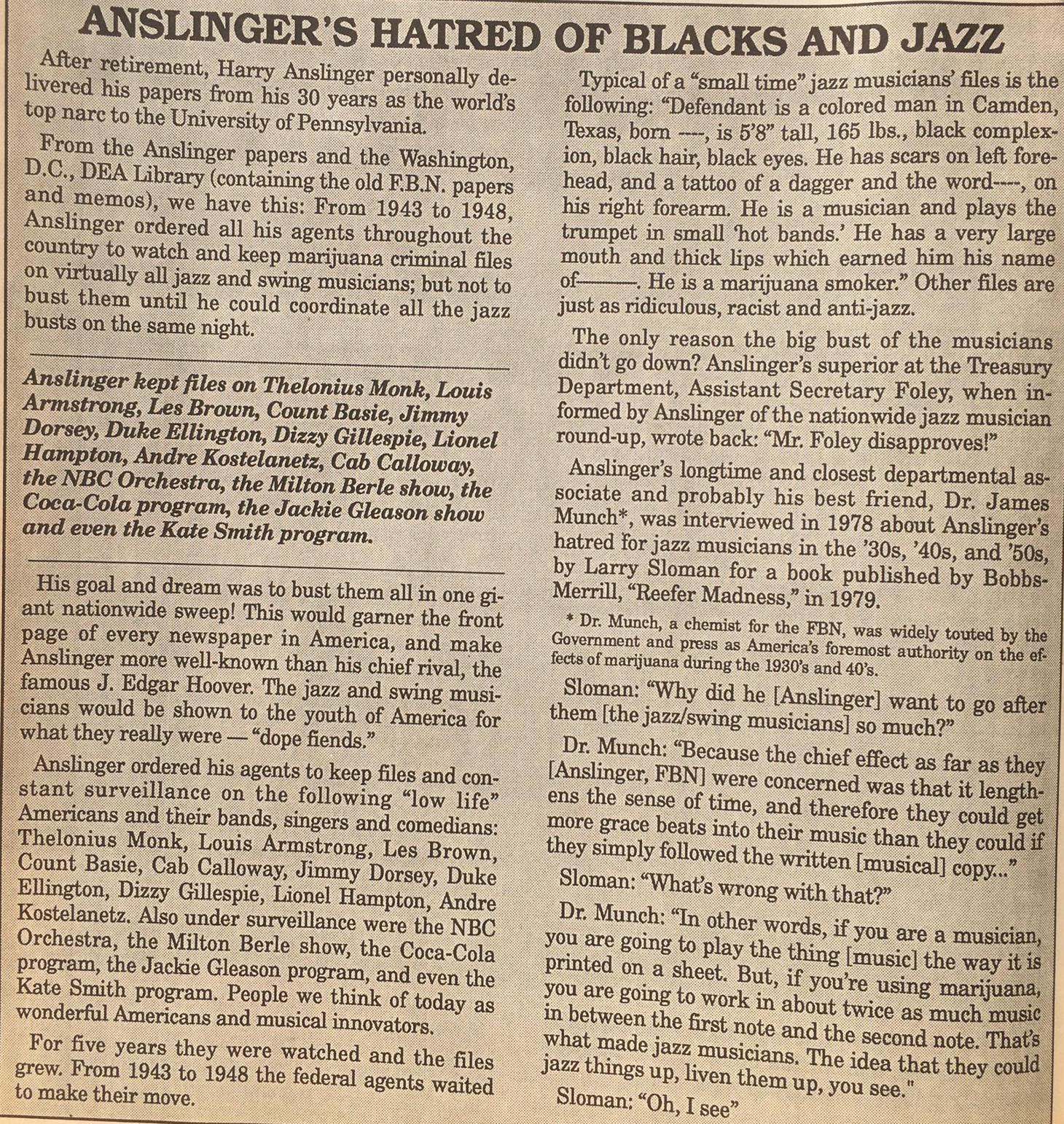
1931: Ventinove stati americani misero fuori legge la marijuana.
1934: Il governo degli Stati Uniti emanò l'“Uniform State Narcotic Act” per sollecitare i rimanenti stati ad accettare la pericolosità della marijuana. La propaganda nazionale fu rafforzata da Harry J. Anslinger con una campagna in cui si affermava che la marijuana fosse causa di insanità mentale.
https://en.wikipedia.org/wiki/Uniform_State_Narcotic_Drug_Act
1936: Il film “Reefer Madness” fu l’apice della propaganda contro la Cannabis, e portò anche alla messa al bando dell'uso di narcotici nei film.
https://en.wikipedia.org/wiki/Reefer_Madness
1937: Il Marijuana Tax Act fu approvato come parte della campagna nazionale "Evil weed" che criminalizzava la marijuana e ne limitava l'accesso anche agli individui autorizzati per usi medici/industriali.
https://en.wikipedia.org/wiki/Marihuana_Tax_Act_of_1937
POI LA PARTE PIU' BELLA
1940s: "Hemp for victory", un film prodotto dal governo, promosse la coltivazione di canapa per i bisogni di guerra (produzione di vestiti, corde ecc..). Ok. Lo stesso governo che ha bandito la Cannabis, una delle principali colture di inizio ‘900, si trova senza materiali per poter rifornire le proprie truppe in guerra. Sembra una barzelletta ma è andata veramente così, tanto da far sì che gli agricoltori che decidevano di produrre Cannabis per rifornire l’esercito venivano esonerati dall'obbligo di arruolarsi.
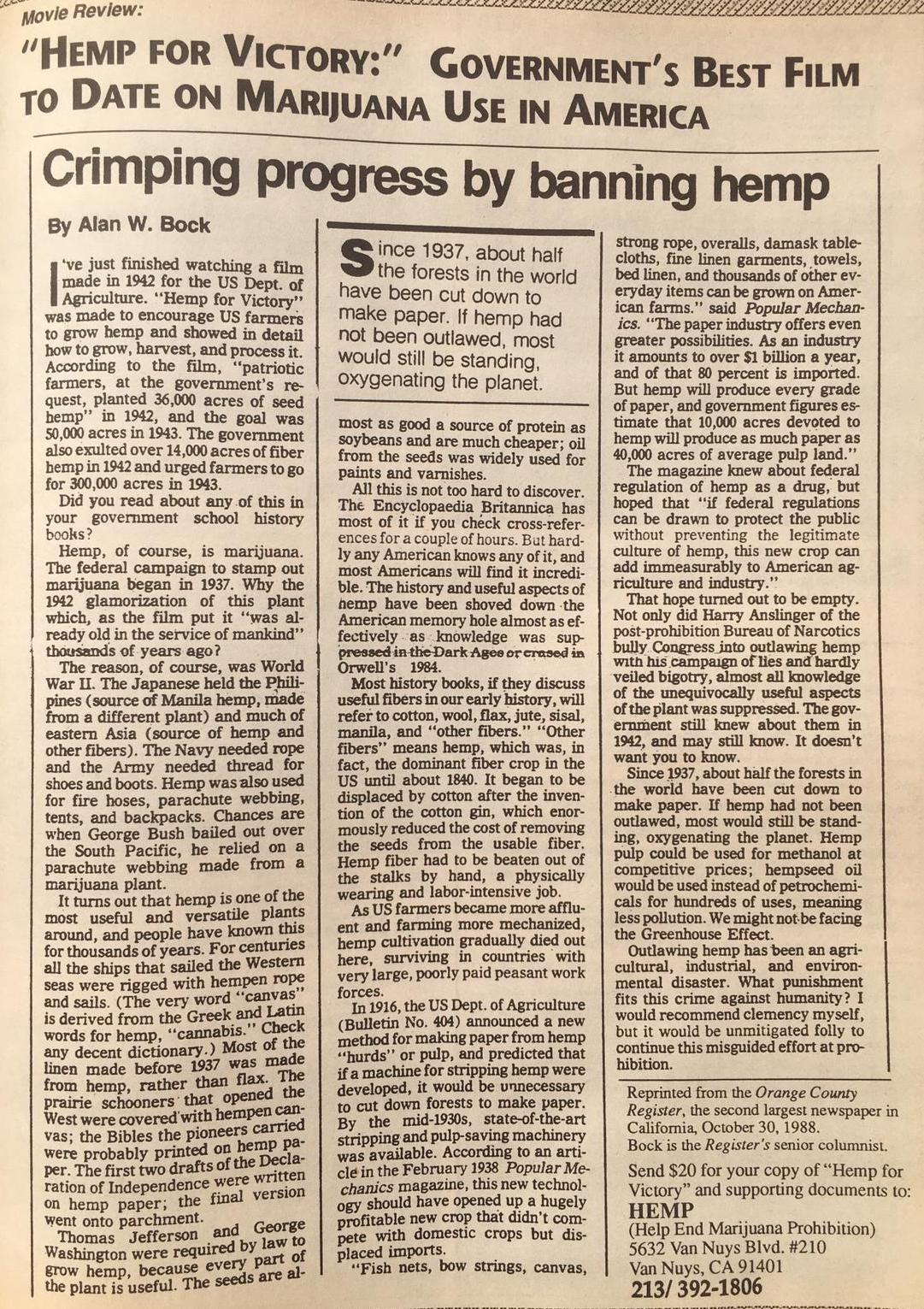
https://en.wikipedia.org/wiki/Hemp_for_Victory
1950s: il Boggs Act (1952) ed il Narcotics Control Act (1956) misero in ginocchio la Cannabis indicendo pene da 2 a 10 anni e fino a $20.000 di sanzioni per i reati collegati alla cannabis. (Queste pene verranno poi rivedute dal congresso nel 1970).
https://en.wikipedia.org/wiki/Boggs_Act_of_1951
1970: Fondazione dell'Organizzazione Nazionale per la Riforma delle Leggi sulla Marijuana (NORML).
1970: Il Controlled Substances Act classificò la marijuana come una droga della Tabella I (pericolosa e senza utilizzi medici), al pari di eroina e LSD.
https://en.wikipedia.org/wiki/Controlled_Substances_Act
1972: Fu istituita la Commissione Shafer (National Commission on Marihuana and Drug Abuse) da parte del presidente Richard Nixon. La commissione venne incaricata di effettuare ricerche che provassero l’impatto della marihuana sull’aumento di criminalità e degrado sociale. Al termine delle ricerche la commissione composta da scienziati e ricercatori presentò un documento (firmato dal presidente stesso della commissione Raymond P. Shafer) intitolato “Marihuana, a signal of misunderstanding” nel quale si demoliva ogni capo d’accusa sociale contro la marihuana e consigliava di mettere fine alla proibizione della Cannabis e di lasciare spazio ai ricercatori per studiare meglio questa pianta. Nonostante questa affermazione data da un ente nazionale di scienziati (anche tramite appello televisivo) l’amministrazione Nixon non ne prese atto ed anzi, rincarò la dose e strinse ancora di più la cinghia attorno alla Cannabis.
https://en.wikipedia.org/wiki/Shafer_Commission
1973: Creazione della Drug Enforcement Administration (DEA).
1976: Nacque il movimento anti-marijuana dei genitori che successivamente, con il sostegno della DEA e del National Institute on Drug Abuse (NIDA), porterà alla Guerra alle Droghe del 1980.
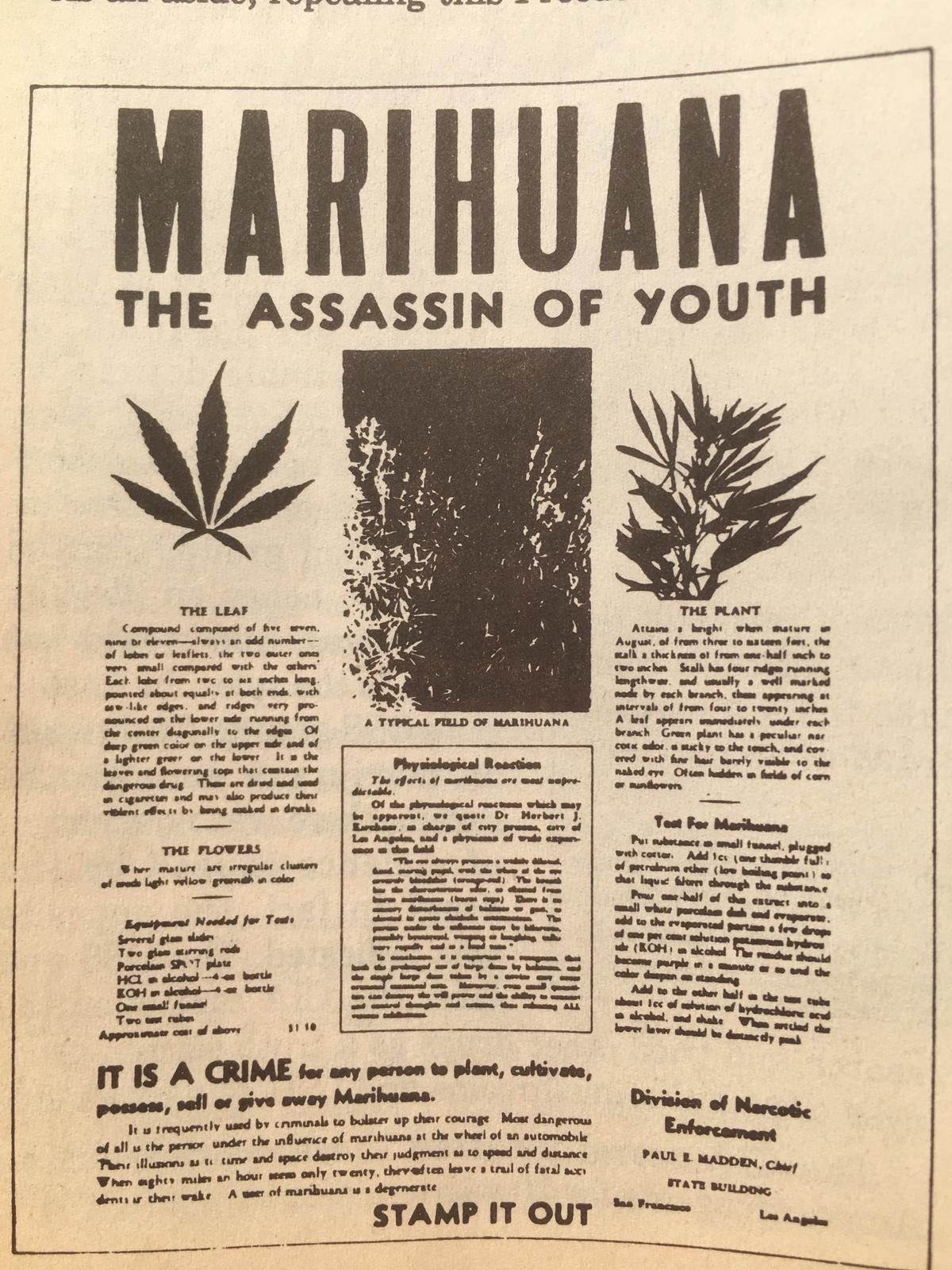
1986: L'Anti-Drug Abuse Act aumentò nuovamente le pene, introducendo la pena obbligatoria e istituendo la regola dei tre colpi.
https://en.wikipedia.org/wiki/Anti-Drug_Abuse_Act_of_1986
1989: Inizia la Guerra alla Droga di George H. W. Bush.
1996: La California diventa il primo stato a legalizzare l'uso medico della Cannabis.
2014: L'emendamento Rohrabacher-Farr impedisce al governo federale degli Stati Uniti di interferire nell'attuazione statale delle leggi e dei regolamenti sulla Cannabis. Persistono tutt’ora negli Stati Uniti conflitti tra leggi nazionali e leggi federali riguardo la Cannabis.
Agosto 2016: La DEA rifiuta di cambiare la riclassificazione della marijuana che rimane nella Tabella 1 dei narcotici.
Novembre 2016: La California legalizza la Cannabis per uso ricreativo. Il primo passo per una reazione a catena che porterà alla legalizzazione e/o liberalizzazione in molti stati degli U.S.
La cronistoria che ho affrontato è principalmente focalizzata su eventi sociopolitici che sono la facciata più popolare della guerra alla Cannabis. Ma, a questi eventi è necessario aggiungere la descrizione di qualche importante interesse economico che si è mosso alle spalle di tutto questo trambusto, in particolare grazie alla famiglia DuPont. Da fine '800 la compagnia della famiglia DuPont era volta allo sviluppo di fibre tessili sintetiche come il nylon. Agli inizi del ventesimo secolo la famiglia DuPont era una tra le famiglie più influenti nella nuova industria americana, tanto da avere tra i suoi investitori nomi importanti del congresso come Andrew Mellon, segretario della tesoreria e terzo uomo più ricco nell'America di quell'epoca, grazie al quale ebbero una grande influenza sulle decisioni politiche prese negli anni ’30. Anche William Randolph Hearst, magnante dei giornali, si schierò contro la Cannabis e pubblicò racconti gialli in cui la Cannabis era messa in correlazione a crimini e a violenza con l'intento di distorcere la percezione pubblica su questa pianta. Inoltre la Cannabis avrebbe potuto anche infastidire il mercato della carta perchè fino a quel momento il materiale per la produzione della carta da giornale derivava dall’utilizzo di legno come materia prima. Siccome per il trattamento del legno era necessario l'utilizzo di solventi chimici, prodotti guarda caso proprio dalla DuPont, era di interesse comune demonizzare la Cannabis perchè essa non necessitava di ricevere trattamenti chimici quanto il legno per la sua trasformazione in carta. DuPont, Mellon e Hearst sono riconosciuti da molti come i mandatari della demolizione dell’industria della Cannabis.
https://en.wikipedia.org/wiki/Du_Pont_family
https://en.wikipedia.org/wiki/Andrew_Mellon
https://en.wikipedia.org/wiki/William_Randolph_Hearst
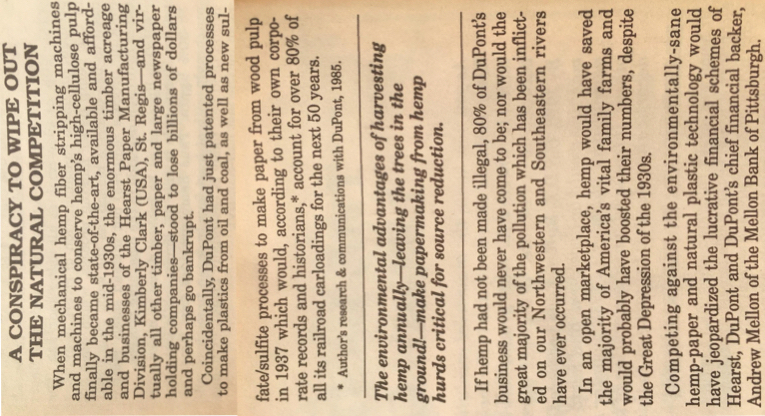
.jpeg)
Tengo a sottolineare che tutti gli eventi fondamentali riguardanti il proibizionismo hanno avuto luogo negli Stati Uniti. Noi europei, ed in particolare noi italiani, ci siamo limitati ad uniformarci alle sentenze espresse da questa potenza internazionale, sebbene ci siano state più volte situazioni che hanno dimostrato il controsenso di questa battaglia e le ripercussioni che avrebbe portato alle istituzioni stesse. Per quanto riguarda la nostra storia con la Cannabis ci basti pensare che il nostro bel paese, fino agli inizi del proibizionismo, era tra i più ambiti produttori di capi tessili in fibra di canapa, tanto da essere scelto dall'impero britannico per rifornire le proprie flotte sia per le divise che per vele, corde ed altre attrezzature.
Questo a grandi linee è il riassunto di ciò che è accaduto durante il ‘900. La nostra eredità dopo tutti questi eventi è solo confusione e disinformazione... in due generazioni abbiamo perso una risorsa fondamentale e ancora oggi è difficile far emergere la verità riguardo questo argomento.
Spero che questo riassunto vi incoraggi a prendere seriamente la discussione sulla Cannabis, al di là delle apparenze e dei luoghi comuni c’è tantissimo da riscoprire e da sviluppare attorno a questa pianta.
#inweedwetrust
#cannabisforfuture
EN
Good morning to the whole community!
Today I want to talk to you about #Cannabis and in particular about its prohibition during the 20th century, I think it's a story that not everyone knows and that is worth reflecting on.
Cannabis, as we all know, is a #plant that has been part of our ecosystem for millions of years, it has been part of human civilization and its uses and customs since ancient times and it had a relevant if not fundamental role in its agricultural/industrial uses until the beginning of the last century and then...total darkness.
Since the beginning of #prohibitionism the ignorance that has made its way around this subject is really impressive, many do not even know what it is exactly about, there is a lot of confusion and very little interest. Yet until a couple of generations before ours, this product of mother earth was the order of the day!
But what can push human beings to declare war to such a common plant? Its dangerousness, as we have been told for decades? Probably yes, but the danger we are talking about is not related to health as they wanted us to believe, but we are talking about danger towards powers that have considered it as an obstacle in their interests, or that have made it a flag to incriminate some uncomfortable social reality.
Yes, these are the real motives of prohibition and the war on Cannabis: racism and economic interests.
Below we go over the history of prohibition and some interesting facts about it.
1600s: In the New World, domestic hemp production proved profitable in the 13 colonies: the Virginia Assembly in 1619 required farmers to grow hemp, a product so important that it was even used as legal tender on the East Coast before the Civil War.

1850: Cannabis was added to the U.S. Pharmacopoeia to treat various symptoms such as opiate addiction, alcoholism, leprosy, and menstrual pain.
1906: President Teddy Roosevelt signed the "Pure Food and Drug Act" in which the labeling of over-the-counter remedies was mandated. *Alcohol, morphine, opium, heroin and marijuana were labeled as "addictive" and/or "dangerous."
https://en.wikipedia.org/wiki/Pure_Food_and_Drug_Act
1900-20s: After the Mexican Revolution, the flows of Mexican immigrants into Texas and Louisiana increased and with it the fear and prejudice against Mexican-American culture.
1930s: In the following years began a real campaign of demonization of this plant. The government of the United States banned the substance called "Marihuana", term used by Mexicans to identify cannabis. The American people did not know how to relate this term to the common cannabis sold as an over-the-counter remedy, so the government was able to ban Marihuana, effectively banning cannabis without facing any opposition. Propaganda began to accuse this substance of being the cause of aggressive and violent behaviors of social minorities (Mexicans and African Americans) and of being a danger to white women and young Americans who could be impaired by using it. All this at a time of great economic depression and great tension within American society.

1931: Twenty-nine American states outlawed marijuana.
1934: The U.S. government enacted the "Uniform State Narcotic Act" to urge the remaining states to accept the danger of marijuana. National propaganda was bolstered by Harry J. Anslinger with a campaign claiming that marijuana was a cause of insanity.
https://en.wikipedia.org/wiki/Uniform_State_Narcotic_Drug_Act
1936: The movie "Reefer Madness" was the pinnacle of anti-Cannabis propaganda, and also led to the banning of narcotic use in movies.
https://en.wikipedia.org/wiki/Reefer_Madness.
1937: The Marijuana Tax Act was passed as part of the national "Evil weed" campaign that criminalized marijuana and restricted access to it even to individuals authorized for medical/industrial uses.
https://en.wikipedia.org/wiki/Marihuana_Tax_Act_of_1937
THEN THE BEST PART
1940s: "Hemp for victory", a government-produced film, promoted the cultivation of hemp for wartime needs (production of clothing, ropes, etc.). Okay. The same government that banned Cannabis, one of the main crops of the early 1900s, finds itself without materials to be able to supply its troops in the war. It sounds like a joke but it really happened that way, so much so that farmers who decided to produce Cannabis to supply the army were exempt from the obligation to enlist.

https://en.wikipedia.org/wiki/Hemp_for_Victory
1950s: The Boggs Act (1952) and the Narcotics Control Act (1956) brought Cannabis to its knees by designating penalties of 2 to 10 years and up to $20,000 in fines for cannabis-related offenses. (These penalties would later be revised by Congress in 1970).
https://en.wikipedia.org/wiki/Boggs_Act_of_1951
1970: Founding of the National Organization for the Reform of Marijuana Laws (NORML).
1970: The Controlled Substances Act classified marijuana as a Table I drug (dangerous and with no medical uses), on par with heroin and LSD.
https://en.wikipedia.org/wiki/Controlled_Substances_Act.
1972: The Shafer Commission (National Commission on Marihuana and Drug Abuse) was established by President Richard Nixon. The commission was charged with conducting research to prove the impact of marihuana on increasing crime and social degradation. At the end of the research, the commission, composed of scientists and researchers, presented a document (signed by the commission's president Raymond P. Shafer) entitled "Marihuana, a signal of misunderstanding" in which it "demolished every social accusation against marihuana" and advised to "end the prohibition of cannabis" and leave room for researchers to better study this plant. In spite of this statement given by a national body of scientists (also through a television appeal) the Nixon administration did not take note of it and, on the contrary, increased the dose and tightened the belt around Cannabis even more.
https://en.wikipedia.org/wiki/Shafer_Commission
1973: Creation of the Drug Enforcement Administration (DEA).
1976: The anti-marijuana parenting movement was born, which would later, with the support of the DEA and the National Institute on Drug Abuse (NIDA), lead to the War on Drugs of 1980.

1986: The Anti-Drug Abuse Act increased penalties again, introducing mandatory sentencing and instituting the three-strikes rule.
https://en.wikipedia.org/wiki/Anti-Drug_Abuse_Act_of_1986.
1989: George H. W. Bush's War on Drugs begins.
1996: California becomes the first state to legalize the medical use of Cannabis.
2014: The Rohrabacher-Farr Amendment prevents the U.S. federal government from interfering in state implementation of cannabis laws and regulations. Conflicts between state and federal laws regarding Cannabis persist to this day in the United States.
August 2016: The DEA refuses to change the reclassification of marijuana, which remains in Schedule 1 narcotics.
November 2016: California legalizes Cannabis for recreational use. The first step in a chain reaction that will lead to legalization and/or liberalization in many U.S. states.
The chronicle I have approached is primarily focused on sociopolitical events that are the most popular facade of the War on Cannabis. But, to these events it is necessary to add the description of some important economic interests that moved behind all this turmoil, particularly thanks to the DuPont family. Since the late 1800s, the DuPont family company had been aimed at developing synthetic textile fibers such as nylon. At the beginning of the 20th century, the DuPont family was one of the most influential families in the new American industry, so much so that they had among their investors important names in Congress such as Andrew Mellon, secretary of the treasury and the third richest man in America at that time, thanks to whom they had a great influence on political decisions made in the 1930s. William Randolph Hearst**, newspaper magnate, also came out against Cannabis and published detective stories in which Cannabis was linked to crime and violence in order to distort public perception of the plant. Moreover, Cannabis could have also "disturbed the paper market" because until then the material for the production of newsprint was derived from the use of wood as raw material. Since the treatment of wood required the use of chemical solvents, which happened to be produced by DuPont, it was of common interest to demonize Cannabis because it did not need to be chemically treated as much as wood for its transformation into paper. DuPont, Mellon and Hearst are recognized by many as the commanders of the demolition of the Cannabis industry.
https://en.wikipedia.org/wiki/Du_Pont_family
https://en.wikipedia.org/wiki/Andrew_Mellon
https://en.wikipedia.org/wiki/William_Randolph_Hearst

.jpeg)
I would like to point out that all the fundamental events regarding prohibition took place in the United States. We Europeans, and in particular we Italians, have limited ourselves to conforming to the rulings expressed by this international power, although there have been several times situations that have demonstrated the nonsense of this battle and the repercussions that it would have brought to the institutions themselves. As far as our history with cannabis is concerned, we need only think that our beautiful country, until the beginning of prohibitionism, was among the most sought after producers of textile garments made of hemp fiber, so much so that it was chosen by the British Empire to supply its fleets both for uniforms and for sails, ropes and other equipment.
This in broad strokes is a summary of what happened during the 1900s. Our legacy after all these events is just confusion and misinformation...in two generations we have lost a vital resource and even today it is difficult to get the truth out about this subject.
I hope this summary encourages you to take the discussion about Cannabis seriously, beyond appearances and clichés there is so much to rediscover and develop around this plant.
#inweedwetrust
#cannabisforfuture

Post eccellente!!!! Qualcosa sapevo, ma non tutto! Davvero un post con tanta qualità
Non ho parole per esprimere il mio parere su questo post, l'ho letto tutto di un fiato come non mi capitava da tempo. Non solo l'idea di ripercorrere questo argomento così attuale, ma la perizia, la documentazione... Ottimo post, non vedo l'ora di leggere il prossimo. Ottimo lavoro avanti così.
Es una gran verdad, y referente al post, es exelente, saludos.
Thank you! I hope the change of ideas that began in recent years expands worldwide as quickly as possible
Ojala que si amigo, sera para mejor.
Anarko